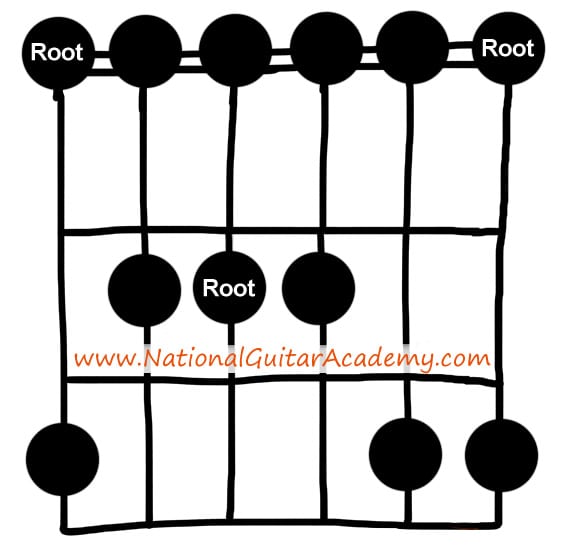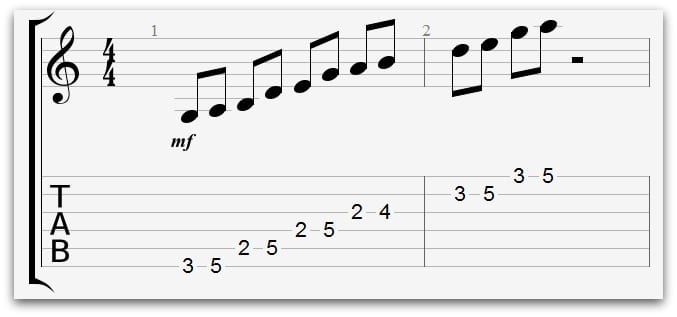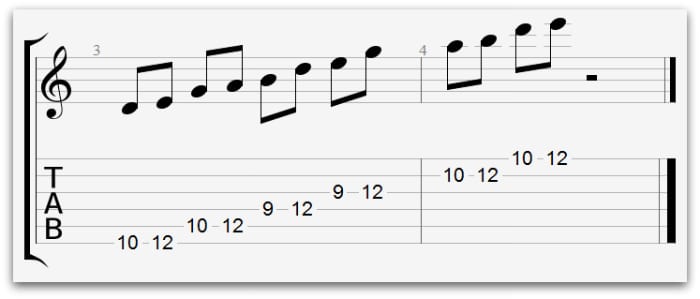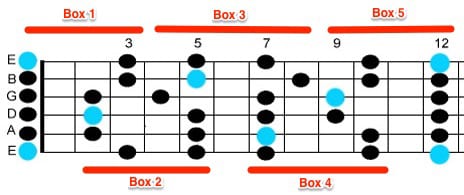The E minor pentatonic scale is a useful and fun guitar scale to know. (It’s the most widely-used scale for lead guitarists.)
In this free guitar lesson you will learn:
- 3 essential E minor pentatonic scale patterns.
- 5 cool licks & flicks in E minor pentatonic that make you sound amazing.
- How to tell when you can use the E minor pentatonic scale (in a way that musically ‘works’ and actually sounds good.)
- 2 must-know secrets for solos.
- How to improvise with a scale.
Over 100,000 guitar-learners get our world-class guitar tips & tutorials sent straight to their inbox: Click here to join them
The classic E minor pentatonic scale pattern
This is the easiest way to play E minor pentatonic.
(There are two pictures below. They show the same scale in tab and chordbox form.)
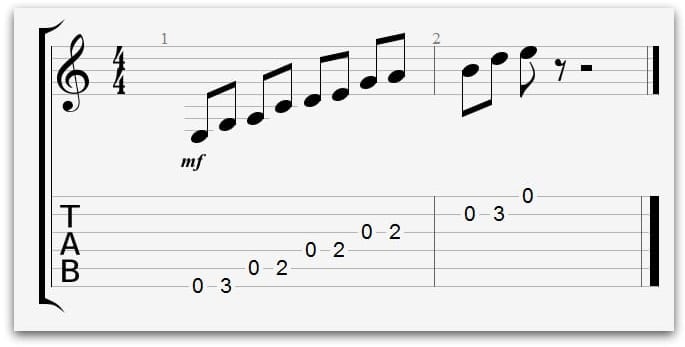
(If you don't understand the above image please read our article "How To Read Guitar Chordboxes In 60 Seconds". It will make everything clear!)
5 cool licks and flicks in the E minor pentatonic scale
In this video Mike shares a few simple-but-awesome-sounding tips for riffing in the E minor pentatonic scale.
Moving it up to the 12th…
One of the cool things about this scale is we can play the same pattern on the 12th fret. (If we do this, we are still playing in E minor pentatonic, but in a higher octave.)
Here’s what this scale should sound like when you play it on the 12th fret:
When you play this scale on the 12th fret, make sure you use the following fingers:
- 1st and 4th fingers on the low E string (6th string).
- 1st and 3rd fingers on the A string.
- 1st and 3rd fingers on the D string.
- 1st and 3rd fingers on the G string.
- 1st and 4th fingers on the B string.
- 1st and 4th fingers on the high E string (1st string).
2 Useful Tips
The E minor pentatonic scale is an abridged version of the E minor scale. The two scales are identical; the pentatonic version simply has two notes removed.
Wondering what a ‘pentatonic’ scale is? The origin of the word ‘pentatonic’ is Latin and simply means ‘5 notes’.
- If you’d like to know more about scales go here: Learn Guitar Scales In 8 Easy Steps
- If you want to know more about theory check out this lesson: Guitar Theory For Dummies
CHECKPOINT: We’re about to run through some more E minor pentatonic scales patterns. If you’re more interested in understanding HOW and WHEN to use this cool scale, then scroll down past the patterns and check out the practical tips and exercises in the lower half of this guide.
Download our lead guitar cheat-sheet to make things easier
It's hard to understand which scales work with which keys.
So we created a cheat-sheet! A key and scale-finder that you can use again and again.

Get your personalised guitar-learning plan 🎸
Get a custom guitar-learning plan here: Click here for GuitarMetrics™
World-Class Guitar Courses 🌎
Learn from the world's best guitar educators: Click here for our guitar courses
More E minor pentatonic scale patterns
We’ve covered the beginner stuff, so now let’s look at a few more advanced patterns of this awesome scale.
It’s important to mention that the root note isn’t the first note in ANY of these patterns. (The placement of the root note changes for each pattern.)
You can find the root notes on the:
- 2nd fret of the D string.
- 5th fret of the B string.
Wondering why root notes are important?
Check out this lesson: How To Play Lead Guitar
Use the following fingers for each string:
- 2nd and 4th on the low E string.
- 1st and 4th on the A string.
- 1st and 4th on the D string.
- 1st and 3rd on the G string.
- 2nd and 4th on the B string.
- 2nd and 4th on the high E string.
Top Tip: Assigning 1 finger per fret is a great way of building individual finger strength and great technique.
E Minor Pentatonic Scale: Pattern 3
This shape is slightly difficult to get under the fingers, but once you have this pattern you will be able to unlock all kinds of pentatonic secrets.
Pay attention to where the root notes are here:
- 7th fret of the A string.
- 5th fret of the B string.
For this pattern use the following fingers:
- 1st and 3rd fingers on the E string.
- 1st and 3rd fingers on the A string.
- 1st and 3rd fingers on the D string.
- 1st and 4th fingers on the G string.
- 1st and 4th fingers on the B string.
- 1st and 3rd fingers on the high E string.
E Minor Pentatonic Scale: Pattern 4
This pattern is great for warming up those fingers and has a great musical quality to it, perfect if you want to spice up your playing.
The root notes for pattern 4 are on the:
- 7th fret of the A string.
- 9th fret of the G string.
Use these fingers for this pattern:
- 1st and 4th fingers on the low E string.
- 1st and 4th fingers on the A string.
- 1st and 3rd fingers on the D string.
- 1st and 3rd fingers on the G string.
- 1st and 3rd fingers on the B string. (Or if you prefer you can use fingers 2 and 4 instead. Experiment with this one!)
- 1st and 4th fingers on the high E string!
Want free guitar tips and video lessons delivered to your inbox?
Join over 100,000 guitar learners and subscribe to our guitar-tips-by-email service. (It's free.)
We'll send you a series of lessons that will move you to the next level of your guitar journey.
Learn how everything fits together quickly, easily and effectively. We share ninja tips (for instant fun!) but also timeless fundamentals that will deepen your understanding.
Our Guitar Courses
To become a better guitarist click here to see our guitar courses
Get your personalised guitar-learning plan 🎸
Want us to make a guitar-learning plan that is customised to you? Click here for GuitarMetrics™
E Minor Pentatonic Scale: Pattern 5
This pattern is the trickiest of all as you have to use your little finger! However, once you get used to using the pinky you will be flying around the fretboard quickly.
The root notes for this pattern are on the:
- 12th fret of the low E string.
- 9th fret of the G string.
- 12th fret of the high E string.
Use these fingers on this pattern:
- 1st and 3rd fingers on the E string.
- 1st and 3rd fingers on the A string.
- 1st and 4th fingers on the D string.
- 1st and 4th fingers on the G string.
- 1st and 3rd fingers on the B string. (Try experimenting with your 2nd and 4th fingers here too.)
- 1st and 3rd fingers on the high E string. (Have a go at using your 2nd and 4th fingers here. You may have a stronger preference here so use what feels best for you.)
Feeling overwhelmed?
Don’t worry about learning all of these scale patterns!! Just pick one. These scale patterns are essential to know, eventually.
Remember there is no rush. You will be a much more musical guitarist if you focus on just one pattern and master it, than if you try to memorise them all rote.
The world is filled with guitarists who know scales. Very few of them are musical. Don’t just ‘learn the patterns’. Pick one pattern and focus all your energy on how and when to use it.
Learn one pattern and stick with it for at last a few months before you take on another one.
The full E minor pentatonic scale – All 5 patterns
Here are the 5 E minor pentatonic patterns laid across the whole guitar neck. (Root notes are highlighted in blue.)
And here’s the tab…
How do I make these patterns sound musical?
A great place to start is our epic ultimate lead guitar guide: How To Play Lead Guitar
An awesome and fun way to spice things up (and feel like a guitar hero) is to use a diagonal pattern.
Over 100,000 guitar-learners get our world-class guitar tips & tutorials sent straight to their inbox: Click here to join them
GUITAR HERO TIME! E Minor Pentatonic Scale ‘Primary Diagonal’
This ‘run’ across the neck skips between 3 patterns.
Try and move through this pattern by just using your 1st and 3rd fingers, it’s important to develop fluidity on the fret board.
Download our lead guitar cheat-sheet to make things easier
It's hard to understand which scales work with which keys.
So we created a cheat-sheet! A key and scale-finder that you can use again and again.

Get your personalised guitar-learning plan 🎸
Get a custom guitar-learning plan here: Click here for GuitarMetrics™
World-Class Guitar Courses 🌎
Learn from the world's best guitar educators: Click here for our guitar courses
Now we’ve learned the scale patterns of the E minor pentatonic scale, let’s check out when & how we can use it…
When can you use the E minor pentatonic scale?
You can play the E minor pentatonic scale over the following musical keys and it will sounds great.
- E Minor
- G Major
- E Major (For a bluesy feel)
- A blues in the key of E
This works well because the E minor pentatonic scale includes notes that are also in these keys.
This isn’t a theory lesson, so we won’t go into this in detail here. If you want to learn more about guitar theory check out this lesson: www.nationalguitaracademy.com/guitar-theory/
So how do I improvise with this scale?
If you want to improvise with the E minor pentatonic scale, you can use ANY of the keys shown above with this scale and it will sound great.
Get our best guitar tips & videos
Where should we send it?
Get our best guitar tips & videos
Get our best guitar tips & videos
Where should we send it?

